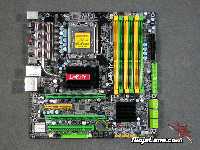After careful consideration I have decided to transfer all hardware review activities to a new domain. I purchased Hardwareasylum.com in 2012 and have been working hard to build a new and improved Ninjalane on that domain. If you are reading this you have reached one of the archived articles, news, projects and/or reviews that were left behind during the site migration.
Please update your bookmarks and be sure to visit the new and improved Ninjalane at Hardwareasylum.com
LanParty Jr X58 T3H6 Motherboard Review
Author: Dennis Garcia
Published: Thursday, March 26, 2009
Introduction
In continuing with our quest to highlight some of the most unique hardware available we have decided to look at some of the current MicroATX motherboards on the market. In the past MicroATX has been associated with mainstream systems that need to be small and quiet. Oftentimes these systems feature all in one designs so there is little to no need for expansion cards. DFI has begun to expand their famed LanParty line to include the MicroATX form factor and thus transforming the subtle and unknown motherboard into a powerful and gaming powerhouse.

In this review we will be looking at the LanParty Jr X58 motherboard by DFI. As the name suggests this is a MicroATX board based on the Intel X58 chipset. Despite the smaller size and limited expansion slots this board is almost identical to the larger LanParty LT X58 and while we won’t be doing a side by side comparison you can see how similar similar they are on the DFI website.
The typical color scheme for Intel based LanParty motherboards is a black PCB with green expansion slots. Optional expansion slots use an alternative color; typically this is a simple yellow. These colors were not always like this, some of the early Intel based LanParty boards were Orange on Black but with the addition of DK line the high end LT boards needed a new color scheme and green was the next logical choice.
The back of the motherboard features the standard i7 reinforcement plate and quite a few additional chips, as you can imagine complicated motherboards require a more components and with a 3rd of the PCB space gone they have to go somewhere.
The back of the motherboard features the standard i7 reinforcement plate and quite a few additional chips, as you can imagine complicated motherboards require a more components and with a 3rd of the PCB space gone they have to go somewhere.



